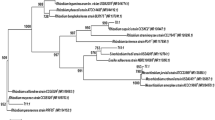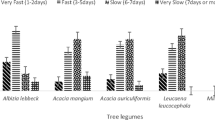Abstract
Pigeon pea (Cajanus cajan) is one of the most important legumes grown in the northern province of Uttar Pradesh, India. However, its productively in Uttar Pradesh is lower than the average yield of adjoining states. During the course of the present study, a survey of pigeon pea growing agricultural fields was carried out and it was found that 80% of plants were inadequately nodulated. The study was aimed to evaluate the pigeon pea symbiotic compatibility and nodulation efficiency of root nodulating bacteria isolated from various legumes, and to explore the phenetic and genetic diversity of rhizobial population nodulating pigeon pea growing in fields of Uttar Pradesh. Amongst all the 96 isolates, 40 isolates showed nodulation in pigeon pea. These 40 isolates were further characterized by phenotypic, biochemical and physiological tests. Intrinsic antibiotic resistance pattern was taken to generate similarity matrix revealing 10 phenons. The study shows that most of the isolates nodulating pigeon pea in this region were rapid growers. The dendrogram generated using the NTSYSpc software grouped RAPD patterns into 19 clusters. The high degree of phenetic and genetic diversity encountered is probably because of a history of mixed cropping of legumes. The assessment of diversity is a very important tool and can be used to improve the nodulation and quality of pigeon pea crop. It is also concluded that difference between phenetic and RAPD clustering pattern is an indication that rhizobial diversity of pigeon pea is not as yet completely understood and settled.




Similar content being viewed by others
References
Ahlawat IPS, Gangaiah B, Singh IP (2005) Pigeonpea (Cajanus cajan) research in India—an overview. Indian J Agri Sci 75:309–320
Alam KMM, Mia S, Akter T, Uddin MS (2015) Screening for market price, protein and sugar contents in ten different varieties of pulse produced and consumed in Bangladesh. Sch Acad J Biosci 3:92–97
Ali SF, Rawat LS, Meghvansi MK, Mahna SK (2010) Determination of the host range of tree and herb rhizobia for their alternative legumes. J Phytol 2:101–106
Amarger N, Macheret V, Laguerre G (1997) Rhizobium gallicum sp. nov. and Rhizobium giardinii sp. nov. from Phaseolus vulgaris nodules. Int J Syst Bacteriol 47:996–1006
Anand RC, Dogra RC (1991) Physiological and biochemical characteristics of fast and slow-growing Rhizobium sp. pigeonpea (Cajanus cajan). J Appl Bacteriol 70:197–202
Anupma Singh SK, Vaishampayan A (2017) Assessment of genetic diversity and symbiotic effectiveness of Pigeon pea (Cajanus cajan) nodulating bradyrhizobia. Indian Res J Genet Biotech 9:179–186
Arora NK, Kumar V, Maheshwari DK (2000) Isolation of both fast and slow growing rhizobia effectively nodulating a medicinal legume, Mucuna pruriens. Symbiosis 29:121–137
Arora NK, Verma M, Mishra J (2017) Rhizobial bioformulations: Past, Present and Future. In: Mehnaz S (ed) Rhizotrophs: Plant Growth Promotion to Bioremediation. Springer Nature, Singapore, pp 69–99
Bhattacharjee S, Sharma GD (2015) Effect of Arbuscular mycorrhizal fungi (AM fungi) and Rhizobium on the nutrient uptake of pigeon pea plant. Int J Adv Res 3:833–836
Bhattacharjee S, Singh AK, Sharma SK (2013) Phosphorus, sulfur and cobalt fertilization effect on yield and quality of soybean (Glycine max L. Merrill) in acidic soil of northeast India. Ind J Hill Farm 26:63–66
Boakye EY, Lawson IYD, Danso SKA, Kwame offei S (2016) Characterization and diversity of rhizobia nodulating selected tree legumes in Ghana. Symbiosis 69:89–99
Carelli M, Gnocchi S, Fancelli S, Mengoni A, Paffetti D, Scotti C, Bazzicalupo M (2000) Genetic diversity and dynamics of Sinorhizobium meliloti populations nodulating different alfalfa cultivars in Italian soils. Appl Environ Microbiol 66:4785–4789
Chen LS, Figueredo A, Pedrosa FO, Hungria M (2000) Genetic characterization of soybean rhizobia in Paraguay. Appl Environ Microbiol 66:5099–5103
Dong R, Zhang J, Huan H, Bai C, Chen Z, Liu G (2017) High salt tolerance of a Bradyrhizobium strain and its promotion of the growth of Stylosanthes guianensis. Int J Mol Sci 18:1625
Elkheir ME, Osman AG (2011) Effects of biofertilization on yield, physical characteristics and chemical composition of pigeon pea (Cajanus cajan L.). Pak J Nutr 10:978–981
Elsheikh EAE, Ahmed EIA (2000) A note on the effect of intercropping and Rhizobium inoculation on the seed quality of faba bean (Vicia faba L.). U K J Agric Sci 8:157–163
Gaur YD, Sen AN (1979) Cross inoculation group specificity in Cicer-Rhizobium symbiosis. New Phytol 83:745–754
George N, Chemining`wa Muthomi JW, Theuri SWM (2007) Effect of rhizobia inoculation and starter-N on nodulation, shoot biomass and yield of grain legumes. Asian J Plant Sci 6:1113–1118
Gómez-Sagasti MT, Marino D (2015) PGPRs and nitrogen-fixing legumes: a perfect team for efficient Cd phytoremediation? Front Plant Sci 6:81. https://doi.org/10.3389/fpls.2015.00081
Haichar FZ, Marol C, Berge O, Rangel-Castro JI, Prosser JI, Balesdent J, Heulin T, Achouak W (2008) Plant host habitat and root exudates shape soil bacterial community structure. ISME J 2:1221–1230
Jarvis BDW, van Berkum P, Chen WX, Nour SM, Fernandez MP, Cleyet-Marel JC, Gillis M (1997) Transfer of Rhizobium loti, Rhizobium huakuii, Rhizobium ciceri, Rhizobium mediterraneum, and Rhizobium tianshanense to Mesorhizobium gen. nov. Int J Syst Bacteriol 47:895–898
Jordan DC (1984) Family III Rhizobiaceae. In: Krieg NR, Holt JC (eds) Bergey’s manual of systematic bacteriology, vol 1. Williams & Wilkins, Baltimore, pp 234–244
Khare E, Arora NK (2014) Effects of soil environment on field efficacy of microbial inoculants. In: Arora NK (ed) Plant microbe symbiosis: applied facets. Springer, India, pp 353–381
Madrzak CJ, Golinska B, Kroliczak J, Pudelko K, Lazewska D, Lampka B, Sadowky M (1995) Diversity among field populations of Bradyrhizobium japonicum in Poland. Appl Environ Microbiol 61:1194–1200
Maloy SR (1990) Experimental techniques in bacterial genetics. Jones and Bartlett, Boston, p 180
Minchin FR, Witty JF, Sheehy JE, Muller M (1983) A major error in the acetylene reduction assay: decreases in nodular nitrogenase activity under assay conditions. J Exp Bot 34:641–649
Mothapo NV, Grossman JM, Maul JE, Shi W, Isleib T (2013) Genetic diversity of resident soil rhizobia isolated from nodules of distinct hairyvvetch (Vicia villosa Roth) genotypes. Appl Soil Ecol 64:201–213
Nautiyal CS, Hegde SV, van BP (1988) Nodulation, nitrogen fixation, and hydrogen oxidation by pigeon pea Bradyrhizobium spp. in symbiotic association with pigeon pea, cowpea, and soybean. Appl Environ Microbiol 54:94–97
Njira KOW, Semu E, Mrema JP, Nalivata PC (2017) Pigeon pea and cowpea-based cropping systems improve vesicular arbuscular mycorrhizal fungal colonisation of subsequent maize on the alfisols in central malawi. Int J Microbiol 2017: Article ID 2096314, 9 pages https://doi.org/10.1155/2017/2096314
Pandey P, Sahgal M, Maheswari DK, Johri BN (2004) Genetic diversity of rhizobia isolated from medicinal legumes growing in the sub-Himalayan region of Uttaranchal. Curr Sci 86(1):202–207
Parker MA, Lafay B, Burdon JJ, van Berkum P (2002) Conflicting phylogeographic patterns in rRNA and nifD indicate regionally restricted gene transfer in Bradyrhizobium. Microbiol 148:2557–2565
Pervin S, Jannat B, Al Sanjee S, Farzana T (2017) Characterization of rhizobia from root nodule and rhizosphere of Lablab purpureus and Vigna sinensis in Bangladesh. Turkish J Agri - Food Sci Technol 5(1):14–17
Pohajda I, Babić KH, Rajnović I, Kajić S, Sikora S (2016) Genetic diversity and symbiotic efficiency of indigenous common bean rhizobia in Croatia. Food Technol Biotechnol 54(4):468–474
Prasad P, Doharey RK, Singh SN, Singh RK, Kumar M, Kumar A (2017) Communication and psychological behavior of the pigeon pea growers in Chitrakoot district, India. Int J Curr Microbiol App Sci 6:2032–2037
Raghuwanshi A, Dudeja SS, Khurana AL (1994) Effect of temperature on flavonoid production in pigeonpea [Cajanus cajan (L) Millsp] in relation to nodulation. Biol Fertil Soils 17:314–316
Rai R, Dash PK, Mohapatra T, Singh A (2012) Phenotypic and molecular characterization of indigenous rhizobia nodulating chickpea in India. Indian J Exp Biol 50:340–350
Relic B, Perret X, Estrada-Garcia MT, Kopcinska J, Golinowski W, Krishnan HB, Pueppke SG, Broughton WJ (1994) Nod factors of Rhizobium are key to the legume door. Mol Microbiol 13:171–178
Sambrok J, Fritsch EF, Maniatis T (1989) Molecular cloning: A laboratory manual. Cold Spring Harbor, New York, 2nd edn, pp 1–3
Shannon CE, Weaver W (1949) The Mathematical Theory of Communication. University of Illinois Press, Urbana, p 117
Shetta ND, Al-Shaharani TS, Abdel-Aal M (2011) Identification and characterization of Rhizobium associated with woody legume trees grown under Saudi Arabia condition. Am Euras J Agri Environ Sci 10:410–418
Somasegaran P, Hoben HJ (1994) Methods in legume-Rhizobium technology. In: Garber RC (ed) Handbook for Rhizobia. Springer Verlag Publications, New York
Sonawane RK, Chavan LS, Kamble AS (2015) Performance of pigeonpea (Cajanus cajan l. millsp) varieties under nutrient management grown in kharif season. Inter J Adv Technol Eng Sci 3:201–208
Subba-Rao NS (1980) Crop responses to microbial inoculation. In: Subbarao NS (ed) Recent advances in nitrogen fixation. Edward Arnold, London, United Kingdom, pp 406–420
Thies JE, Bohlool BB, Singleton PW (1991) Subgroups of the cowpea miscellany: symbiotic specificity within Bradyrhizobium spp. for Vigna unguiculata, Phaseolus lunatus, Arachis hypogaea, and Macroptilium atropurpureumt. Appl Environ Microbiol 57:1540–1545
Tilak KVBR (1993) Bacterial Fertilizers. ICAR, New Delhi, pp 1–63
Vincent JM (1970) Root nodule symbiosis with Rhizobium. In: Quispel A (ed) The biology of nitrogen fixation. Oxford Publishing, North-Holland, pp 265–341
Wdowiak-Wro´bel S, Marek-Kozaczuk M, Kalita M, Karas´ M, Wo´jcik M, Małek W (2017) Diversity and plant growth promoting properties of rhizobia isolated from root nodules of Ononis arvensis. Ant van Leeuwen 110:1087–1103
Yadav AS, Nehra K (2013) Selection/isolation of high temperature tolerant strains of Rhizobium for management of high temperature stress on Rhizobium- legume symbiosis. Int J Microbial Res Technol 2(1):47–57
Zilli JE, Valisheski RR, Filho FRF, Neves MCP, Rumjanek NG (2004) Assessment of cowpea Rhizobium diversity in Cerrado areas of northeastern Brazil. Braz J Microbiol 35:281–287
Acknowledgements
Authors are thankful to Prof H K Sehgal, former Vice Chancellor, CSJMU, Kanpur and NKA & ST are grateful to Vice Chancellor, Prof R C Sobti, BBA University for his support.
Author information
Authors and Affiliations
Corresponding author
Ethics declarations
Conflict of interest
The authors declare that they have no conflict of interest in the publication.
Rights and permissions
About this article
Cite this article
Arora, N.K., Khare, E., Singh, S. et al. Phenetic, genetic diversity and symbiotic compatibility of rhizobial strains nodulating pigeon pea in Northern India. 3 Biotech 8, 52 (2018). https://doi.org/10.1007/s13205-017-1074-1
Received:
Accepted:
Published:
DOI: https://doi.org/10.1007/s13205-017-1074-1




